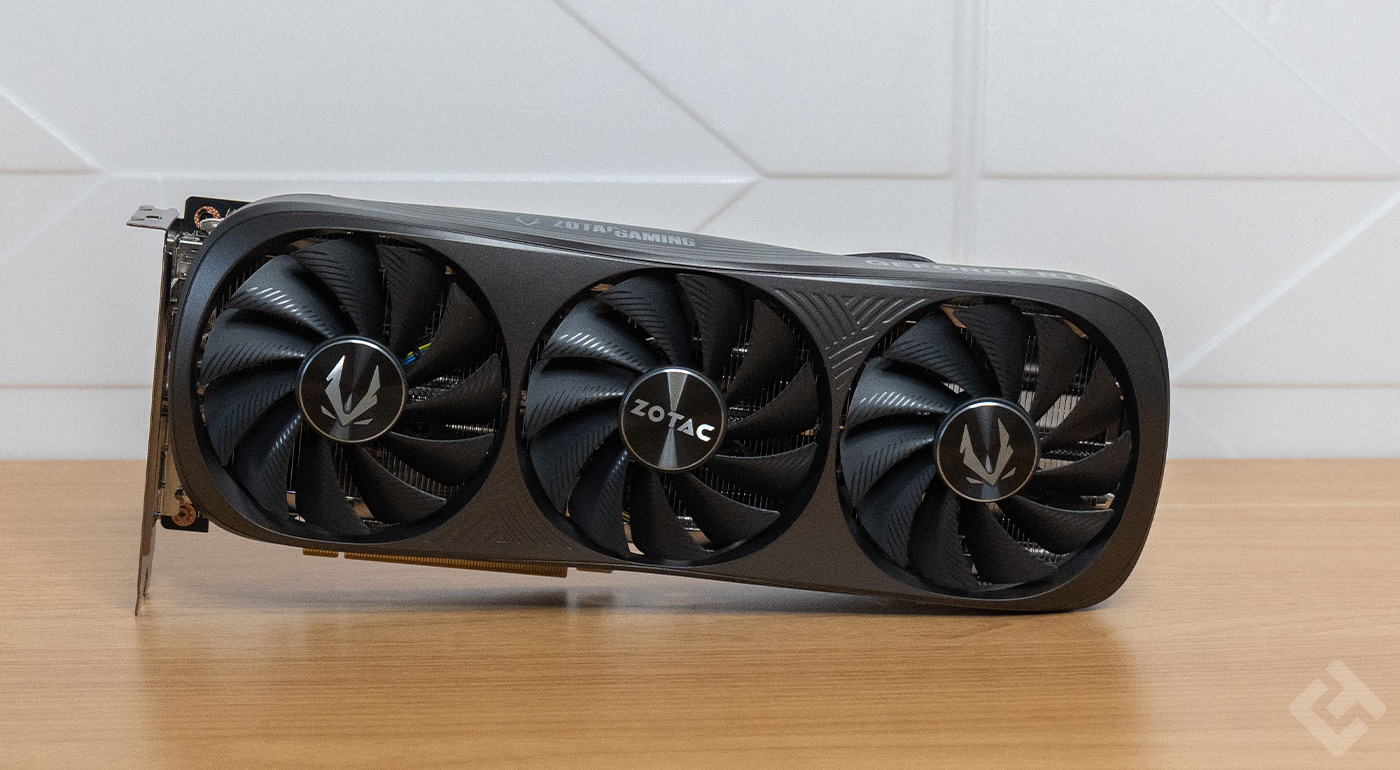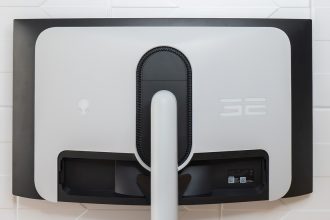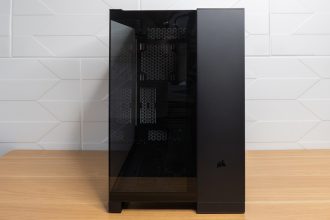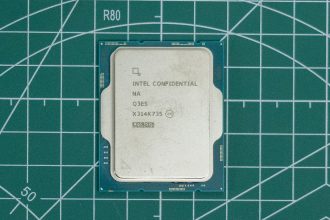The Zotac GeForce RTX 4080 Super Trinity is a high-performance, yet compact graphics card from Nvidia’s new “Super” range. This card stands out by virtue of its rather reduced size compared to its competitors, but its performance is not to be outdone. It’s true that graphics cards are getting bigger all the time, but Zotac is keeping a tight rein on its size. Let’s see what it’s like in the full Zotac 4080 Super Trinity review.
Design of the Zotac GeForce RTX 4080 Super Trinity
If graphics cards tend to look the same, Zotac’s cards have their own design, slim and not too aberrant in size. The card does, however, bear a striking resemblance to other references found on other models, such as the previous RTX 4080 Trinity, which I tested on its release. Here, although the card looks excessively like the other one, it’s well thought-out: not only is it a decent size, but it’s also not too heavy, which means it fits nicely in a computer, without necessarily needing an extra stand. However, Zotac does supply a stand to hold the card securely. On the other hand, it’s not always possible to use it. Yes, it’s handy, but it’s not the support supplied with MSI’s imposing RTX 4070 Ti Suprim X.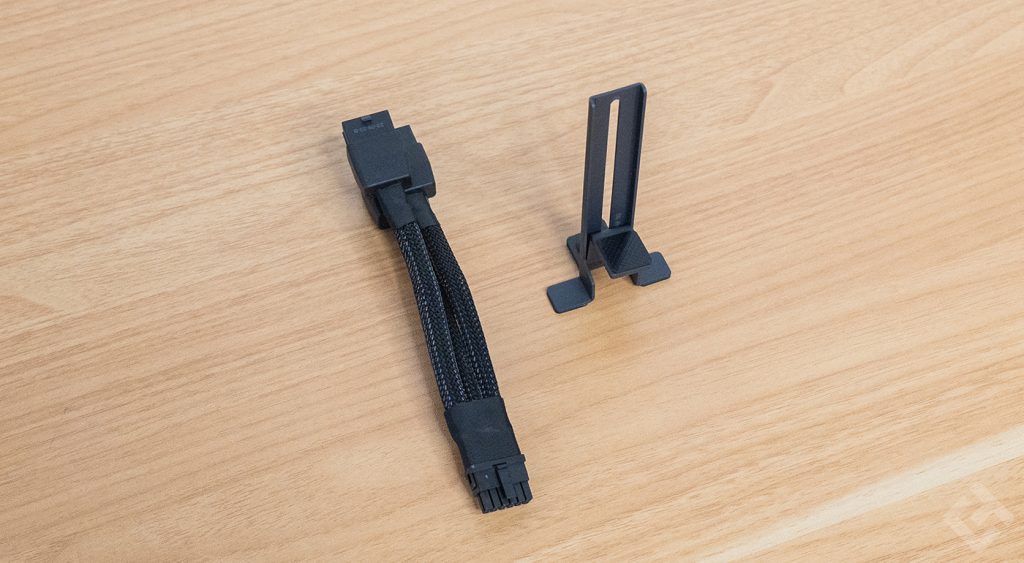
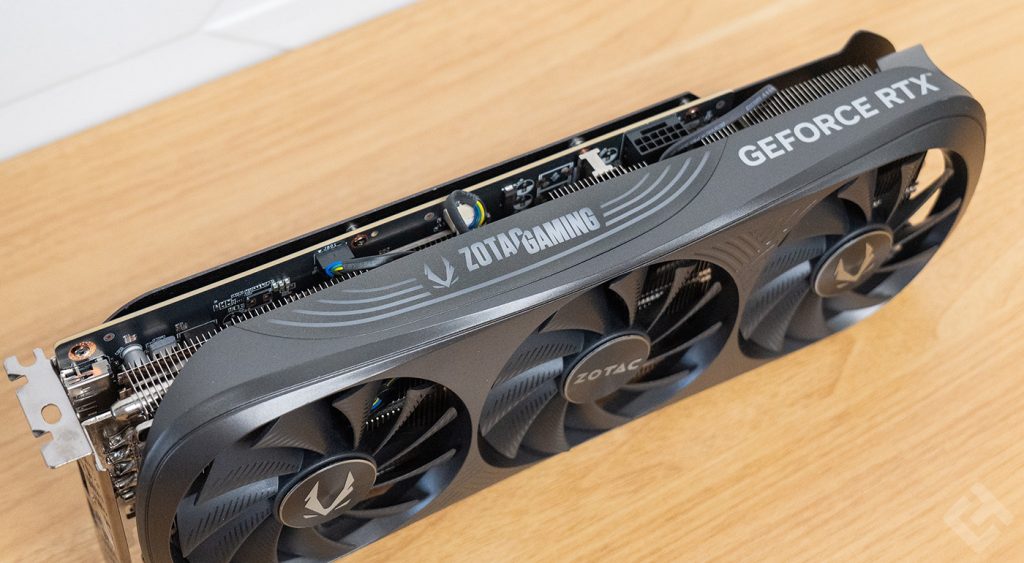
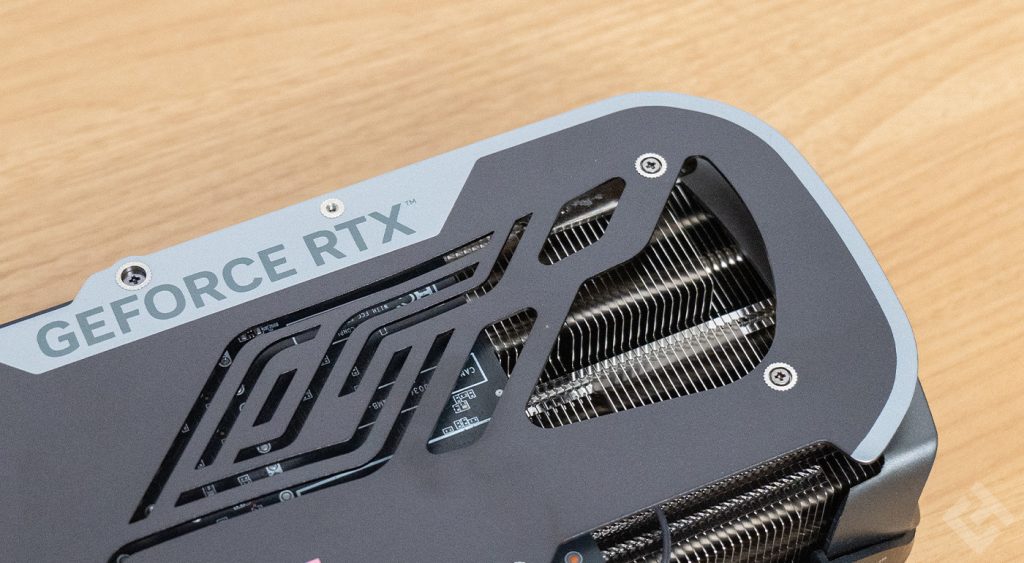
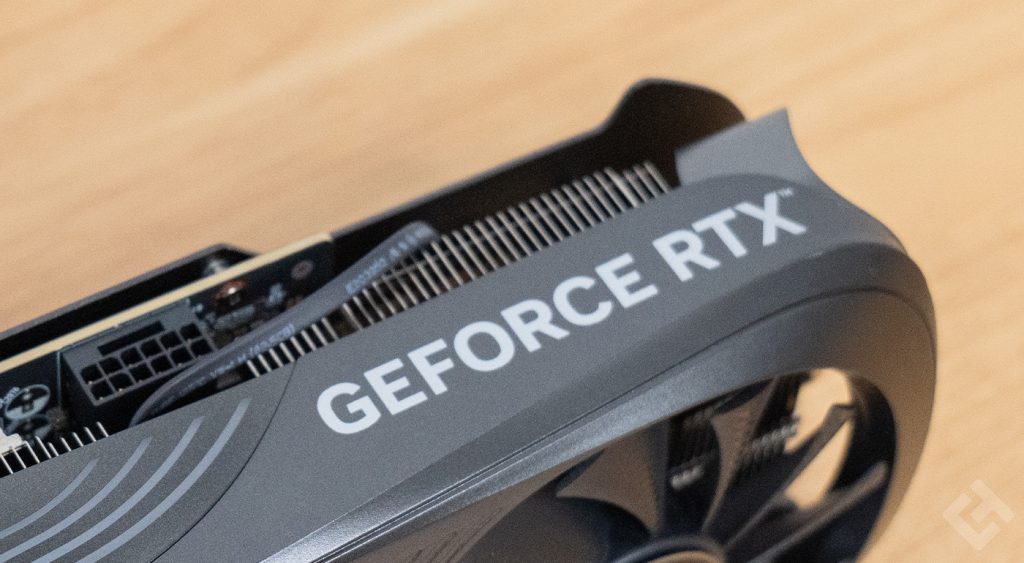
- 3 DisplayPort 1.4a connectors
- 1 HDMI 2.1 connector
This is all you need for a graphics card. The manufacturer could have added a USB-C DisplayPort, but this is not the choice made by the majority of manufacturers, so there’s nothing wrong with that.
Zotac GeForce RTX 4080 Super Trinity specifications
| Model | Zotac GeForce RTX 4080 Super Trinity |
| Graphics processor | Nvidia GeForce RTX 4080 Super |
| Standard bus | PCI Express 4.0 x16 |
| CUDA cores | 10240 |
| Memory | GDDR6X |
| VRAM quantity | 16 GB |
| Memory bus | 256-bit |
| Base chipset frequency | 2295 MHz |
| OC frequency | 2550 MHz |
| Number of monitors supported | 4 |
| Multi GPU | No |
| Maximum digital resolution | 7680 x 4320 @ 60 Hz |
| HDCP process support | 2.3 |
| Power consumption | 320 watts |
| Recommended power supply | 750 watts |
| Power connector | 3 x 8 pins / ATX 3.0 |
| Connectors |
|
| Virtual reality | Yes |
| Direct X | 12 Ultimate |
| Open GL | 4.6 |
| Dimensions | 281 x 114 x 40 mm |
| Ray Tracing support | Yes |
Zotac GeForce RTX 4080 Super Trinity performance
With its new graphics cards, Nvidia isn’t promising a revolution: the manufacturer has simply increased the number of CUDA cores on its cards, as well as the number of AI and Ray-Tracing cores. But Nvidia hasn’t stopped there: the cards’ base frequency has been increased very slightly, from 2205 MHz to 2295 MHz. Similarly, the boosted frequency has been increased from 2505 MHz to 2550 MHz.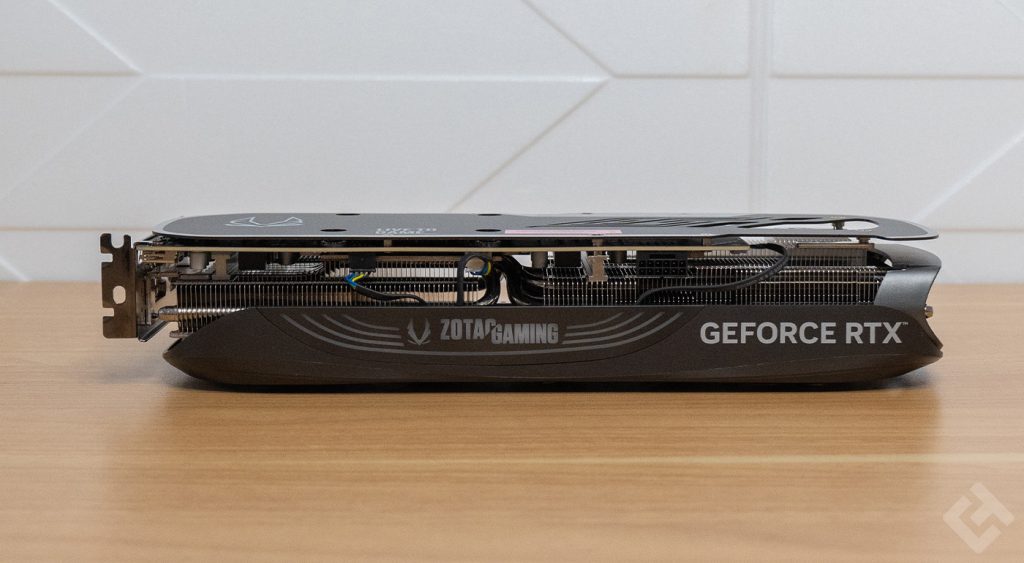
- Motherboard: MSI MPG Z790 Carbon Max WiFi
- Processor: Intel Core i9 13900K
- RAM: 2 x 16 GB Corsair Dominator Titanium
- Case: Corsair 6500X
- Power supply: Corsair RM1000x Shift
A pretty solid configuration, allowing you to run all your games without any worries, and not risk bottlenecking the card.
Less powerful than a previously tested RTX 4090, notably from Asus TUF, it still delivers very decent performance. However, on certain benchmarks, it sometimes performs significantly better than any of its competitors, and sometimes even better than the RTX 4090! This is quite astonishing, after all, it’s only a few scores on 3DMark – nothing is more revealing than several hours of gaming. But here, the benchmarks are already very encouraging, with good performance to show for it. What’s also interesting is the DLSS part, with very slightly improved performance here, but nothing too earth-shattering either. Depending on the card, however, there may be peaks or troughs in performance that I can’t explain. The Zotac RTX 4080 we tested previously struggled in 4K with DLSS 3 enabled, while this card performed exceptionally well on FireStrike Ultra, so not everything is the same. But we can see a little more in gaming, with really good performance on the three games tested, all with DLSS enabled of course.
Game performance
So, performance isn’t bad, but in the benchmarks, which were carried out identically to the rest and on several occasions, performance is excessively changeable. However, it’s never “bad”. The card always manages to offer something decent, the rendering is of high quality and we can only appreciate the performance, however, starting with Cyberpunk, we notice a few weaknesses.
It’s easy to play with, but performance sometimes lags behind other cards in different ranges. This is particularly true of games like Forza Horizon 5, where I was able to repeat the benchmarks several times in a row, in two very similar configurations. But Zotac’s card pays for its compact size, to the detriment of its performance. Indeed, when compared to Asus ROG’s Strix model, performance can sometimes be quite different, but it’s all a question of cooling. In any case, the Zotac GeForce RTX 4080 Super Trinity remains a good model, which has the advantage of costing less than the competitor’s model mentioned above. Admittedly, the cooling isn’t as good, but the card remains much more compact. It also has the advantage of fitting into more cases, which is important depending on your configuration choices.
Cyberpunk 2077
Not every game is an absolute value in terms of performance. Here, on Cyberpunk, a game that consumes both GPU and CPU resources, performance is sometimes better, sometimes worse, than on Asus’ competitor. However, the Zotac GeForce RTX 4080 Super Trinity holds its own, delivering almost identical, if not generally better, performance, which is a very good thing – points gained for this card with its compact look.
F2 2022
On F1 2022, performance is adequate for gaming in all cases, but is not on a par with the aforementioned competitor. In any case, the card delivers very good performance for gaming, whatever the situation, allowing you to play with a 4K 144 Hz screen without any worries and enjoy the game to the full. If you want even more fluidity, a 1440p slab will do the trick.
Shadow of the Tomb Raider
On this game, the Zotac GeForce RTX 4080 Super is right in the middle of what you’d expect from such a card. If we compare it again with the Asus ROG competitor, performance is similar, or even sometimes to the advantage of the Zotac card. It delivers exceptional performance, especially in Full HD, with frame rates that are sometimes aberrant, over 700 fps at maximum. Which doesn’t help much in itself, but only serves to justify the GPU’s high performance.
Assassin’s Creed Mirage
Zotac’s model has a few weaknesses when it comes to more demanding games. Indeed, while performance is good, as soon as the card is heavily used and starts to heat up, its performance slows down. However, it’s not bad: we can reach a maximum of 178 fps in 4K Ultra HD, which is still very decent.
Forza Horizon 5
On Forza Horizon 5, the difference in performance between Zotac’s RTX 4080 Super and the Asus ROG is clearly evident. Performance is still good enough to play with exemplary fluidity, but it’s not up to the level of the well-cooled competitor. It’s a shame, but there’s nothing dramatic about it, as the quality of the game remains ideal.
Alan Wake II
On Alan Wake II, with Path Tracing enabled, performance is not exceptional with this GPU, as the game in question is very resource-hungry. On average, therefore, we find ourselves at less than 100 fps in 4K Ultra HD. However, it’s still perfectly playable, and with the type of game that Alan Walk II is, between 100 and 144 fps, it’s not always easy to feel the difference.
Temperatures and power consumption
In view of the card’s compact size – I was very surprised myself when I took it out of the box – it’s advisable to have a well-cooled PC. Indeed, with three front fans, it’s no luxury. For good reason, the Zotac GeForce RTX 4080 Super tends to heat up quickly. Having done a heat-up test with OCCT, in 2 minutes, for 100% use, it was stabilized at around 80°C. This is important, so making a card with a compact size is all very well, but making a card that cools efficiently seems to be a better option. As for power consumption, Zotac recommends a 750 watt power supply with this RTX 4080 Super Trinity. The card itself can consume up to 320 watts, which is what OCCT actually displays.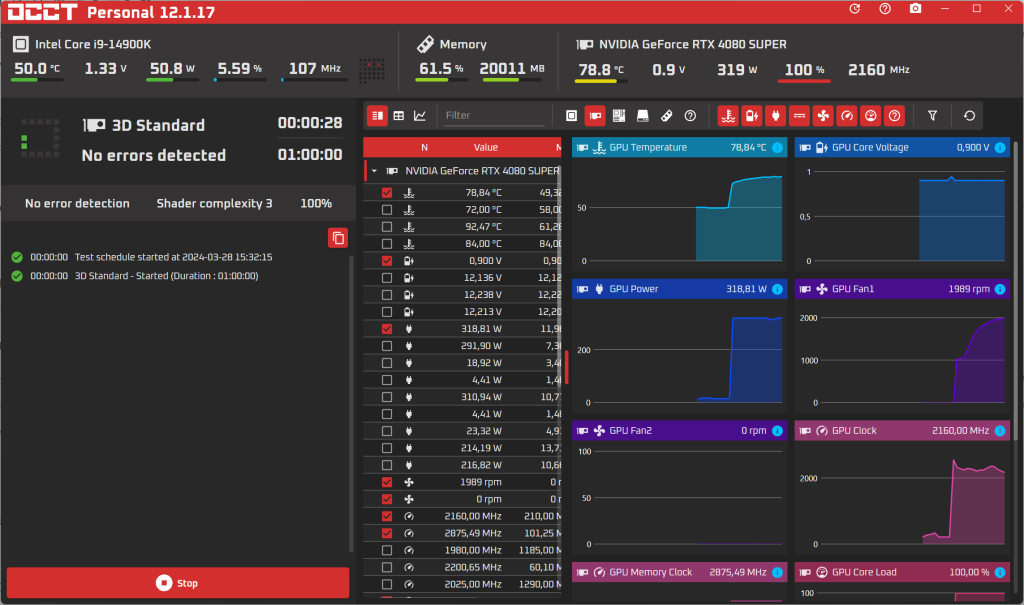
Zotac GeForce RTX 4080 Super Trinity connectivity
The Zotac GeForce RTX 4080 Super Trinity connects to the motherboard via a PCIe 4 or 5 slot, or an earlier version if you have an older card. I wouldn’t recommend this, however, as performance will be degraded, with a chipset that can’t keep up.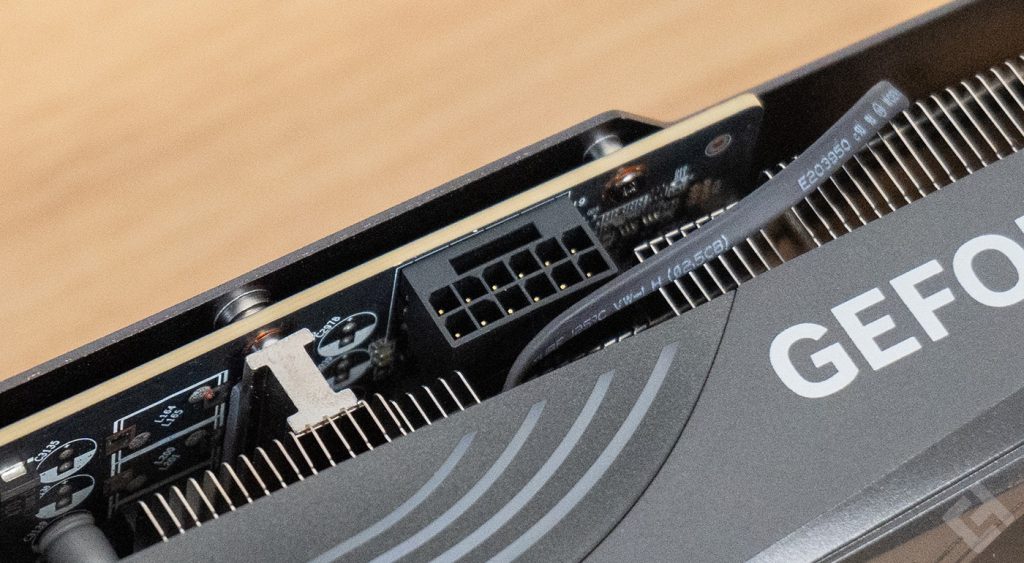
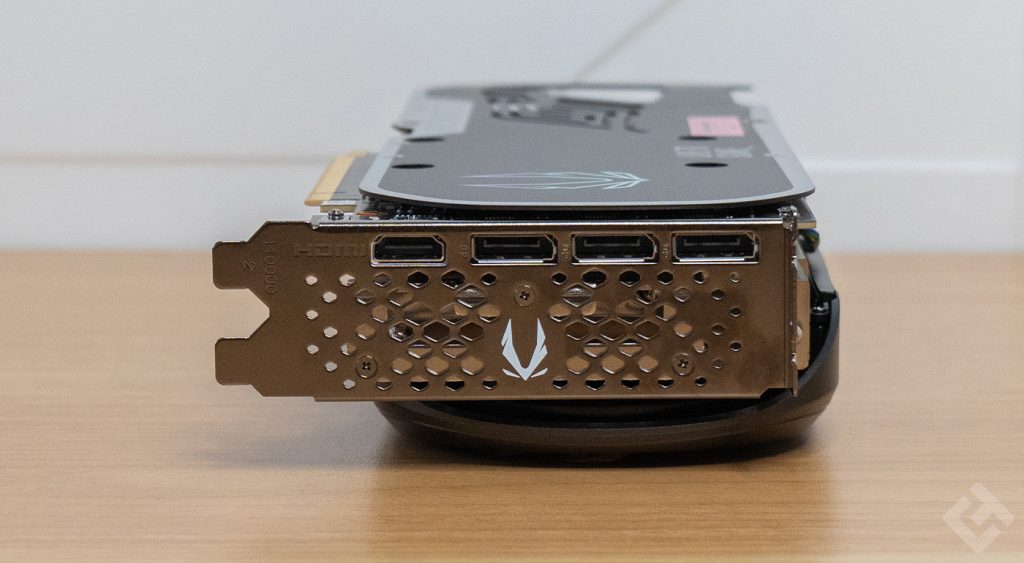
Zotac GeForce RTX 4080 Super Trinity : Reviews
The Zotac GeForce RTX 4080 Super Trinity pays for its compact size, sometimes to the detriment of its performance. Nothing dramatic though, this card is still very good for playing any game up to 4K Ultra HD.


